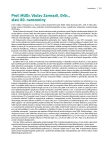Multiple Endocrine Neoplasia I (Wermer‘s Syndrome), Forms of Clinical Manifestation, 5 Case Studies
Authors:
Karolína Drbalová 1; Kateřina Herdová 1; Petr Krejčí 1; Monika Nývltová 1; Svatopluk Solař 1; Lenka Vedralová 1; Pavel Záruba 2; David Netuka 3; Petr Bavor 4
Authors‘ workplace:
Interní ambulantní oddělení Interní kliniky 1. LF UK a ÚVN – Vojenská fakultní nemocnice Praha
1; Chirurgická klinika 2. LF UK a ÚVN – Vojenská fakultní nemocnice Praha
2; Neurochirurgická a neuroonkologická klinika 1. LF UK a ÚVN – Vojenská fakultní nemocnice Praha
3; Chirurgická klinika 2. LF UK a FN v Motole, Praha
4
Published in:
Vnitř Lék 2016; 62(Suppl 3): 140-149
Category:
Case Reports
Overview
Multiple Endocrine Neoplasia (MEN) is a condition in which several endocrine organs of an individual are affected by adenoma, hyperplasia and less often carcinoma, either simultaneously or at different stages of life. Two existing syndromes, MEN1 and MEN2 (2A, 2B), in literature is also mentioned MEN4, are associated also with other non-endocrine disorders. MEN1 (Wermer syndrome) affects the pituitary, parathyroid, and pancreatic area. 95 % of patients show very early manifestation of hyperparathyroidism, often before 40 years of age. Multiple adenomas gradually involve all four parathyroid glands. The first clinical sign of MEN1 includes recurrent nephrolithiasis. The second most frequent manifestation of MEN1 is pancreatic area (pancreas, stomach and duodenum), again multiple malignancies of varying degree which can metastasize. Most often gastrinomas and insulinomas are involved. Pituitary adenomas occur in about one third of MEN1 patients and tend to be larger and less responsive to treatment. Tumors appearing most often are prolactinomas, tumors producing growth hormone, or afunctional adenomas. The other endocrine tumors include carcinoids and adrenal lesions. In the last year we have registered four MEN1 syndrome patients in our center and one patient has been already followed since 2008. In four out of five patients, nephrolithiasis after 30 years of age was the first clinical symptom, but only one of theses cases resulted in MEN1 diagnosis. In all patients, the clinical symptoms intensified and the diagnosis was established between 36 and 40 years of age. A crutial factor is a cooperation with the urology examination of kidney stones formation in young individuals with nephrolithiasis in order to reveal the potential cases of MEN1 syndrome very early on. Consider the MEN1 genetic diagnostics if recurrent primary hyperparathyroidism or recurrent gastroduodenal ulcer disease appear in patients under 40 years of age.
Key words:
carcinoid – gastrinoma – hyperparathyroidism – insulinoma – MEN1 – multiple endocrine neoplasia – nefrolithiasis – neuroendocrine tumor – pancreatic area – pituitary gland
Sources
1. Thakker RV. Multiple endocrine neoplasia type 1 (MEN1) and type 4 (MEN4). Mol Cell Endocrinol 2014; 386(1–2): 2–15. Dostupné z DOI: <http://dx.doi.org/10.1016/j.mce.2013.08.002>.
2. Wermer P. Genetic aspect of adenomatosis of endocrine glands. Am J Med 1954; 16(3): 363–371.
3. Carroll W. Multiple endocrine neoplasia type 1 (MEN1). Asia Pac J Clin Oncol 2013; 9(4): 297–309. Dostupné z DOI: <http://dx.doi.org/10.1111/ajco.12046>.
4. Waldmann J, Lopez CL, Langer P et al. Surgery for multiple endocrine neoplasia type 1 – associated primary hyperparathyroidism. Br J Surg 2010; 97(10): 1528–1534. Dostupné z DOI: <http://dx.doi.org/10.1002/bjs.7154>.
5. Montenegro FLM, Lourenco DM Jr, Tavares MR. Total parathyroidectomy in a large cohort of cases with hyperparathyroidism associated with multiple endocrine neoplasia type 1: experience from a single academic center. Clinics 2012; 67(Suppl 1): S131-S139.
6. Brunová J, Bruna J. Mnohočetná endokrinní neoplazie. In: Brunová J, Bruna J. Klinická endokrinologie a zobrazovací diagnostika endokrinopatií. Maxdorf Jessenius: Praha 2009: 321–333. ISBN 978–80–7345–190–5.
7. Tonelli F, Giudici F, Giusti F et al. Gastroenteropancreatic neuroendocrine tumors in multiple endocrine neoplasia type 1. Cancers 2012; 4(2): 504–522. Dostupné z DOI: <http://dx.doi.org/10.3390/cancers4020504>.
8. Cryer PE, Axelrod L, Grossman AB et al. Evaluation and management of adult hypoglycemic disorders: an endocrine society clinical practice guideline. J Clin Endocrinol Metab 2009; 94(3): 709–728. Dostupné z DOI: <http://dx.doi.org/10.1210/jc.2008–1410>.
9. Hanazaki K, Sakurai A, Munekage M et al. Surgery for a gastropancreatic neuroendocrine tumor (GEPNET) in multiple endocrine neoplasia type 1. Surg Today Mar 2013; 43(3): 229–236. Dostupné z DOI: <http://dx.doi.org/10.1007/s00595–012–0376–5>.
10. Falconi M, Plöckinger U, Kwekkeboom DJ et al. Well-differentiated pancreatic nonfunctioning tumors/carcinoma. Neuroendocrinology 2006; 84(3): 196–211.
11. Jensen RT, Niederle B, Mitry E et al. Gastrinoma (duodenal and pancreatic). Neuroendocrinology 2006; 84(3): 173–182.
12. Thakker RV, Newey PJ, Walls GV et al. Clinical practice guidelines for multiple endocrine neoplasia type 1 (MEN1). J Clin Endocrinol Metab 2012; 97(9): 2990–3011. Dostupné z DOI: <http://dx.doi.org/10.1210/jc.2012–1230>.
13. Vergès B, Boureille F, Goudet P et al. Pituitary disease in MEN type 1 (MEN1): data from the France-Belgium MEN1 Multicenter Study. J Clin Endocrinol Metab 2002; 87(2): 457–465.
14. Burgess JR, Shepherd JJ, Parameswaran V et al. Spectrum of pituitary disease in multiple endocrine neoplasia type 1 (MEN 1): clinical, biochemical, and radiological features of pituitary disease in a large MEN 1 kindred. J Clin Endocrinol Metab 1996; 81(7): 2642–2646.
15. Christakis I, Qiu W, Silva Fiqueroa AM et al. Clinical Features, Treatments, and Outcomes of Patients with Thymic Carcinoids and Multiple Endocrine Neoplasia Type 1 Syndrome at MD Anderson Cancer Center. Horm Cancer Aug 2016; 7(4): 279–287. Dostupné z DOI: <http://dx.doi.org/10.1007/s12672–016–0269-y>.
16. Asgharian B, Turner ML, Gibril F et al. Cutaneous tumors in patients with multiple endocrine neoplasm type 1 (MEN1) and gastrinomas: prospective study of frequency and development of criteria with high sensitivity and specificity for MEN1. J Clin Endocrinol Metab 2004; 89(11): 5328–5336.
17. Vidal A, Iglesias MJ, Fernández B et al. Cutaneous lesions associated to multiple endocrine neoplasia syndrome type 1. J Eur Acad Dermatol Venereol 2008; 22(7): 835–838. Dostupné z DOI: <http://dx.doi.org/10.1111/j.1468–3083.2008.02578.x>.
Labels
Diabetology Endocrinology Internal medicineArticle was published in
Internal Medicine

2016 Issue Suppl 3
Most read in this issue
- Congenital Adrenal Hyperplasia in Adults
- Multiple Endocrine Neoplasia I (Wermer‘s Syndrome), Forms of Clinical Manifestation, 5 Case Studies
- Vitamin D and autoimmune thyroid diseases
- Central Thyroid Disorders
